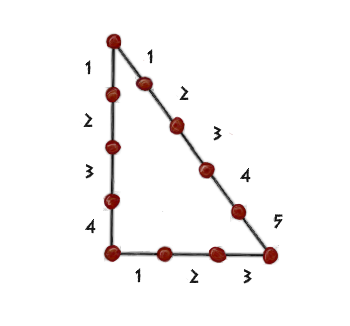The ❂ddly𝓢ee

𝗥eminiscent of 𝐇omer's "𝜤𝓁𝘪𝘢𝘥" (𝚨ncient 𝐆eek: "I'll add [them numbers]"),
this work brings back the great ❂𝖽𝖽𝗅𝗒𝓢𝖾𝖾𝑢𝑠 (/ˈəd-lee-zeeus/ "sees odd things"), a numerically derived hero who factored the 𝔾'odds in ℍ'even and transcended unreal realm of transfinite integers to finally arrive home — back where he started — in time to roll back this sisyphean boulder of an Epic Cycle.
This semi-serious series is an exploration of storytelling about numbers and code compiled from first-hand testimonies of the 𝓙ava𝓢cript speaking peoples of the 𝐆eek 𝐈slands.
A casual narrative introduces ideas drawn from the common heritage of humankind, dipping in and out of freezing waters of formal arguments. Other than the story and overall composition I make no claim of original contribution.
This narrative draws enough inspiration from the real world to keep going but without the burden of absolute compatibility with anything other than itself. Your kind suggestions, comments, and corrections are most welcome.
[angelofdev𝝠𝗼𝘂𝘁𝗹𝗼𝗼𝗸.𝗰𝗼𝗺]

Having spent 𝟭𝟬 long years fighting the Trojan War
On his way back having spent 𝟏𝟎 years more
This 𝗼𝗱𝗱 𝗵𝛜𝗿𝗼, still so hopeful and excited,
Dreamt of next 𝟙𝟘 years at home
— Delighted —
Home
Summary
Ancient Geeks use cultural mentions of celestial twins Sirius and Canopus, the brightest of all stars, to establish themselves as "first ancestors" of all other people. They believe a pre-ordained destiny to leave Ithaca, their home, to settle a verdant oasis given to them — their promised ION.

[Ithaca], third island of Canopus — an archipelago named after the second-brightest star of sky, located over 300 light-years away in constellation of Carina, the keel of Argo Navis, a celestial group named after the ship sailed by Ancient Greeks who arrived long after us.
We, the [Ancient Geeks], told stories of Canopus and its heavenly twin Sirius long before their names were written for the first time on a slab of clay many millennia ago; long before hymns and tales of a sage who seeded Canopus in oral traditions of our successors; when We, the Ancient Geeks, emerged to begin the first "epic cycle".
Canopus outshone all long before its twin Sirius — the [Star of Tsars] — moved towards Earth and rose in the dark — brightest of all, this evil portent of heat and fevers to suffering humanity, with perpetual fire that burns celestial altar through to sacrificial Earth held down in suffocating grip by Canopus, rising anew — this dominator of night — to herald the next epicycle.

The passions of dune dwellers align to the rising star, while restless nomads comb through the barren space-time-desert, with Canopus Star Trackers illuminating their way to verdant oasis they, perhaps foolishly, believe awaits them.
And so, [once more], they found ION.
References
REF-01
🔹Rogers, John H. (1998). "Origins of the Ancient Constellations: I. The Mesopotamian Traditions". Journal of the British Astronomical Association. 108 (1): 9–28.
REF-02
🔹George Nicholas Atiyeh (1 January 1995). The Book in the Islamic World: The Written Word and Communication in the Middle East. SUNY Press. ISBN 978-0-7914-2473-5.
Cited by Wikipedia:Canopus
"The southeastern wall of the Kaaba 🕋 in Mecca is aligned with the rising point of Canopus"
REF-03
"Many spacecraft carry a special camera known as a Canopus Star Tracker"
REF-04
🔹 Homer (1997). Iliad. Trans. Stanley Lombardo. ISBN 978-0-87220-352-5. 22.33–37
"Sirius rises late in the dark, liquid sky
On summer nights, star of stars,
Orion's Dog they call it, brightest
Of all, but an evil portent, bringing heat
And fevers to suffering humanity."
REF-05
🔹 Abhyankar, K. D. “Folklore and Astronomy: Agastya a Sage and a Star”, Current Science 89, no. 12 (2005): 2174–76
🔹 K Chandra Hari, "On the Visibility of Agastya (Canopus) in India", Indian Journal of History of Science, 51.3 (2016) 511-520
REF-06
🔹 Tomkin, Jocelyn (April 1998). "Once and Future Celestial Kings". Sky and Telescope.
REF-07
"The Bedouin people of the Negev and Sinai knew Canopus as Suhayl, and used it and Polaris as the two principal stars for navigation at night."
REF-08
🔹 Complete Rig Veda in English (Sakala Shakha)
"He is one of those indefinable mythic personages who are found in the ancient traditions of many nations, and in whom cosmogonical or astronomical notions are generally figured.
Thus it is related of Agastya that the Vindhyan mountains prostrated themselves before him; and yet the same Agastya is believed to be the regent of the star Canopus."
TOBE
To BE
We of Right to be,
to proclaim, to propagate,
here on own behalf declare:
We are, and ought to be free, autonomous and self-aware.
Every hero needs a cape a bracelet.
To make yours, take a piece of string,
with 12 equally spaced knots mark 12 equally long segments.
Tie the string into a loop.


Now, carefully rearrange the string and hold it taut to reveal a Right Triangle hidden in the circle.
There's only one way to do it with your bracelet (without stretching it), can you see it yet?
Count the segments on each edge (you should end up with: 𝟑, 𝟒 and 𝟓).
Those are the lengths of your triangle's sides.
Mark them as 𝗮, 𝗯 and 𝗰.


We've just made something!
This is a Pythagorean Triangle,
a tool for small construction projects.
Ancients used it to build pyramids.
But how and why does this number-bracelet work?
And what even is "number"?
TheRightToBe
The Most Delicate Balance
A beginning is the time for taking the most delicate care that the balances are correct.
This every sister of the Bene Gesserit knows.🔹 Princess Irulan, “Dune", p.2.
Level of Abstraction.
Choosing the starting Level of Abstractions is never easy.
Too much of it inflates costs and effort, too little of it disables ability to adopt to change.
Without data at this point, a "good abstraction" might just as well "fell good", living close to the collective comfort zone and as close to "the real" as can be.
It "feels good" because it makes everything easier to understand and to communicate.
So don't over-analyze, just decide on something, try it out, gather feedback and adjust accordingly.
As a very minimum, it must help to understand the "who is who" and "who is where" types of questions.
Context.
Context is everything within a set boundary in which something is to be understood.
For example, we are people living on Earth which we share with other animals, plants and fungi.
Here the "context" is the Earth and the things that live on it. Simple to explain but not necessarily helpful in our case.
We are also both "self-" and "mutually-" aware products-of and participants-in our environment in which we survive by negotiating access to limited resources in a way that promotes our shared values, common long-term goals and our collective, ongoing survival.
Self-aware means that we each can recognise ourselves as an individual, as a component of a bigger whole or as the bigger whole itself.
Mutually-aware means that we can recognise each other as individuals, as components of a bigger whole or as the bigger whole itself.
Environment is everything that is, both physical and abstract, with all of the resources and all of the participants, and their ongoing interactions with everything that is.
Here the "context" is more abstract, with many more definitions of not non-obvious terms which are still not necessarily helpful in our case.
We are geeks, professionally involved in software engineering and architecture, determined to make more sense of the world we live in.
We do hope to geek away ideas that are (to us) interesting, to build things, not all useful and to enjoy code and maths without rigid expectations set by work or school.
Our guiding principles:
- If it's fun and interesting - do it.
- If it's just interesting - make it fun, someone might then do it for you.
- If it feels like work, it might be work.
Four Pillars
OPAL
OPAL

In his Oddly Odd Log, he logs things that he's learned,
like thoughts of the others, or their phrases well-turned.
There's this oddly odd page he views all of the time
with the Nymph he entangled — like two conjoined primes.
Some called her Dryope — the loving Tree Nymph,
She now lives between pages, trapped there like a jinn.
But he still calls her OPAL, after the stone fused to her skin.
(let me tell you whole story, so you know what I mean)
At night when they went to a shady old grove — en route,
in pitch-dark — they sat on sappy sapped root ...
With this small blasphemy — the root trapped her foot —
brought blight to their lives, with force of a brute.
From under thick leaves lying bare on the ground,
a new branch shot up shackling tight wooden bound.
Stem fibres soon stiffened — .. you found me .. as always ..
Then she clenched fists in pain — .. but will you be able to find me again? ..
— I always will, yes, we always will be.
— .. and we always will, yes .. that's how it must be.
Her both arms spread out — like two leafy stiff twigs,
Her heart then turned OPAL — preserved in cage of her ribs.
Wait until the next long cycle,
when everything starts anew.
Yet, He always goes and finds Her, Yet, She always knows it's true.
[hamadryades:𝗮𝗻𝗴𝗲𝗹𝗼𝗳𝗱𝗲𝘃]